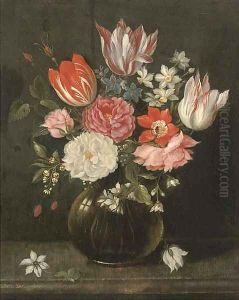Jakob Marrel Paintings
Jakob Marrel was a German painter and engraver, best known for his still life paintings, particularly those depicting flowers. Born in Frankfurt am Main in 1614, Marrel was part of a tradition of Northern European still life artists that flourished during the 17th century. His work often reflects the detailed observation and high technical skill characteristic of this genre.
Marrel began his artistic training under Georg Flegel, a still life painter in Frankfurt, before moving to Utrecht in the Netherlands around 1634. There, he became a student and assistant of Jan Davidsz. de Heem, one of the most renowned still life painters of his time. De Heem's influence is evident in Marrel's work, particularly in his attention to the texture and surface of objects and in the complex compositions he employed.
In Utrecht, Marrel became connected to a circle of artists, and his work began to flourish. During the 1640s, he returned to Frankfurt, where he became a successful painter and teacher. Marrel's works from this period show a mastery of the still life genre, with an emphasis on floral pieces that were popular with the wealthy patrons of the time. His flower still lifes are characterized by their vivid colors, the variety of species included, and the attention to detail in the depiction of each bloom.
Marrel also contributed to the field of natural history through his detailed illustrations of plants and insects. He worked on a book titled 'Thesaurus Florum', which was a collection of flower illustrations, although it was never completed. His engravings of plants were not only artistic but also scientific in their precision and attention to detail. This dual interest in art and science was typical of the period, reflecting the broader cultural movements of the Baroque and the early Enlightenment.
Later in his career, Marrel continued to work in Frankfurt and took on pupils, one of whom was Rachel Ruysch, who would go on to become a highly successful still life painter in her own right. Marrel's legacy is embedded in the way he combined technical skill with a deep appreciation for the natural world, influencing a generation of artists who followed him.
Jakob Marrel’s work is still appreciated today for its contribution to the still life genre. His paintings can be found in museums and collections across Europe, serving as an enduring testament to the richness of the still life tradition in Northern European art. He died in Frankfurt am Main in 1681.
